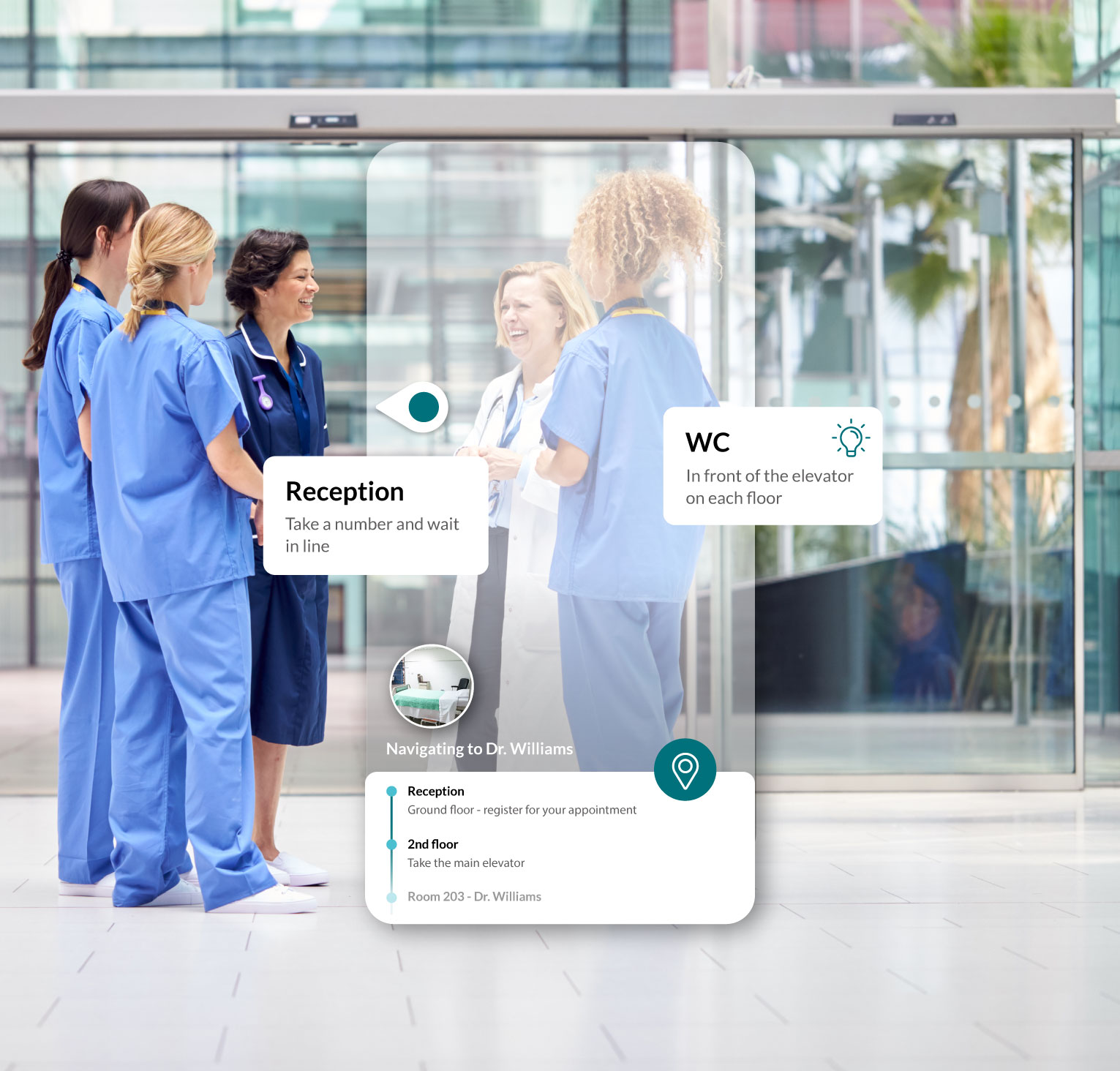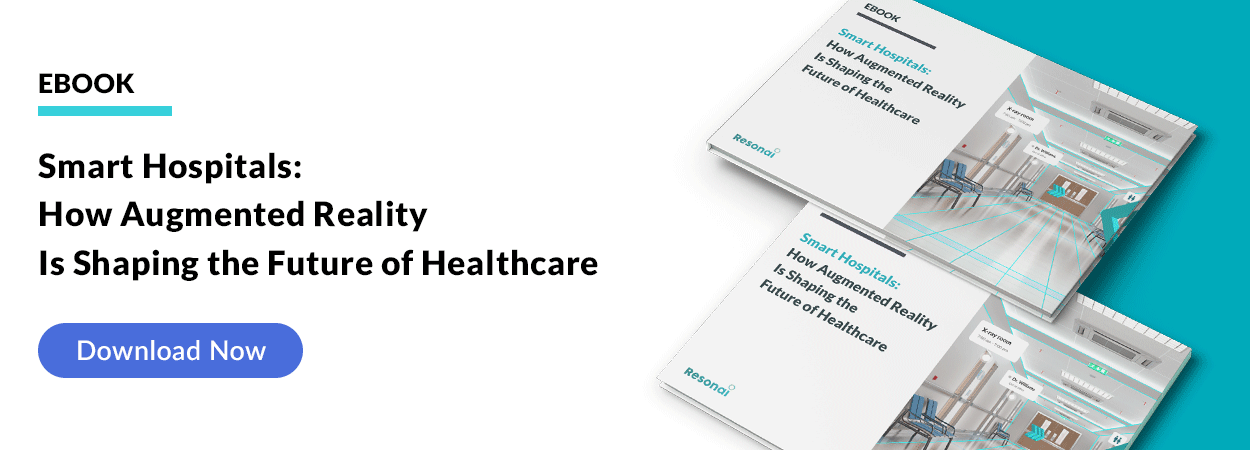How Augmented Reality Hospitals Are Providing Better Patient Experiences
Four ways in which AR is helping patients stay better informed and leave hospitals more satisfied with their healthcare experience

Augmented reality (AR) is galvanizing the healthcare industry in new ways every day.
From facility oversight to preventive maintenance, AR helps managers run hospitals and clinics more efficiently. Augmented reality hospitals aren’t just a boon for the staff, however. AR experiences empower patients to take more control of their health as well as their interactions with medical staff. They also improve the quality of a patient’s visit to a medical facility regardless of whether it’s a quick check-up or an extended stay.
In this article, we’ll explore just a few of the many patient-centric opportunities created by augmented reality hospitals and care facilities.
Jump to a section…
Why augmented reality hospitals lead to better patient outcomes
More effective patient education
Empower patients to navigate locations on their own
Take the stress out of waiting
Help patients describe their symptoms more accurately
Why augmented reality hospitals lead to better patient outcomes
Patient satisfaction isn’t just about making healthcare facilities more enjoyable. Patient compliance is a constant challenge for all health professionals, regardless of setting. With augmented reality, hospitals and other healthcare facilities can increase the likelihood that patients will keep appointments (and be there on time!) while maintaining drug or therapy regimens at home. AR is a key tool for achieving every clinician’s primary goal: better patient outcomes.
Here are just some of the ways that augmented reality can elevate patient care.
Empower patients to navigate hospitals on their own
Is there anything worse than getting lost in a hospital? Trying to find your way to or from a patient’s room can quickly become a frustrating, or even frightening, event for anyone. AR provides a perfect solution with indoor navigation that guides users along the best path to their destination, both indoors and outdoors. Using the camera on your phone, AR places virtual arrows over the image of the actual surroundings in real-time. Users can get wherever they need to be without asking for help — or can get to help quickly in case of an emergency.
The Vera Concierge application is a prime example of how augmented reality can be used to help patients navigate medical facilities with ease. It combines precise AR navigation with contextually-aware content and experiences. Patients or staff can access AR content at key locations as they navigate the facility including everything from facility tutorials to care charts. Content can be updated remotely by admins, allowing for improved efficiency and engagement over traditional mediums.
More effective patient education
It’s not always easy for clinicians to explain procedures or medical conditions in terms that their patients or their loved ones can understand easily, especially in the stress of the moment. The more informed a person is, the better their outcome is likely to be. But more than that, patients deserve to feel confident about their care. With augmented reality, many medical professionals have been able to leverage visual aids to support their explanations of procedures or the effects of the patient’s diagnosed condition. Instead of trying to visualize what the doctor is saying, patients and their families can see the problem firsthand and ask informed questions. AR can also help convey the seriousness of a condition or the need for a specific procedure — a valuable time-saver when dealing with people hesitant to take the doctor at their word.
Perhaps the best application of AR with regard to patient education is drug information. The World Health Organization (WHO) reports that approximately 125,000 deaths each year result from people not taking their medication correctly. Though medical facilities do their best to provide patients with all the relevant details about their prescriptions, it’s often overwhelming. Pages and pages of obtuse language in tiny text is only helpful for someone with the patience and ability to absorb it all. AR can put that information in plain language tailored to the patient’s particular use case. Rather than covering every possible eventuality, the app can coach the user on precisely what they need to know about potential interactions or side effects. The easier it is for patients to understand the risks and necessity of a drug regimen, the more likely they are to do it properly.
Take the stress out of waiting
All healthcare facilities have at least one thing in common: patients and their families spend a lot of time waiting. At the best of times, waiting is just plain boring, but downtime in a hospital can be highly stressful for visitors no matter what their physical complaint. AR can prove a valuable distraction for any age patient. After downloading a facility’s AR program to their mobile device, they can choose from an assortment of apps to suit their moods, such as games, educational apps, shopping, and more. This sort of engagement is particularly helpful for kids, who may need extra help staying focused, relaxed, and quiet in a medical setting.
The Vera Universal Controller application can be used to provide guests with intuitive guides on how to interact with facilities and make the most of their time spent waiting.
Help patients describe their symptoms more accurately
Without a doubt, one of the greatest challenges in healthcare for both patients and doctors is a mutual understanding of symptoms. Patients struggle to find words that accurately describe what they’re experiencing, often inadvertently leading clinicians down the wrong diagnostic path. One classic example of this is in ophthalmology, where the verbiage often boils down to “Is this better or worse?” With augmented reality, optometrists can work with the patient to create accurate visual representations of how they see. AR can also help patients understand how their eyes change with age or as medical conditions progress.
How Vera can help
Healthcare can be a source of fear and confusion for patients. Illnesses and injuries are obvious stressors, but even happy events like pregnancies can be emotionally taxing. Intelligent and empathetic application of augmented reality can bolster patients’ confidence, allay their fears, and make them active partners in their health.
Vera is an augmented reality platform that creates patient-centric digital experiences in healthcare settings. AR navigation and contactless interactions give patients more autonomy over their visits to care facilities. Having the Vera app with them on their phones gives patients a consistent expectation and experience throughout the site. Facility managers can update Vera with new apps to enhance the patient experience or respond to feedback.
Are you ready to learn more? Get in touch with Resonai today and set up a free demonstration.
Subscribe to Our Newsletter!
Read More
How Vera Improves Healthcare Facilities for Patients and Site Managers
When was the last time you heard anyone excited about an upcoming doctor’s appointment, or hospital...
How Augmented Reality Addresses Four of the Most Common Patient Complaints
Patient satisfaction has become an increasingly important factor in determining a medical...
5 Examples of Augmented Reality In Modern Healthcare Facilities
At one time, augmented reality (AR) was little more than science fiction. Today, it plays a major...
